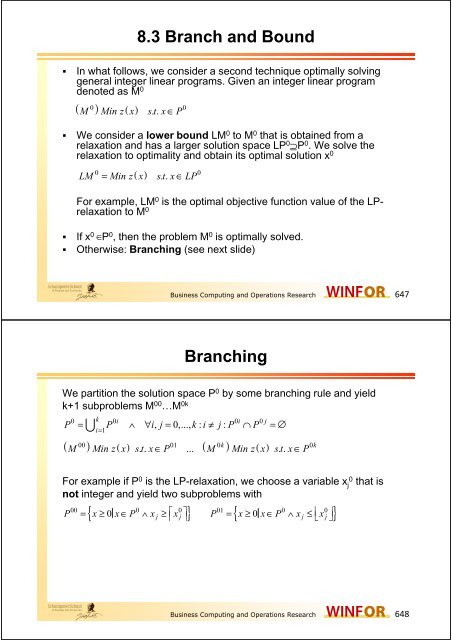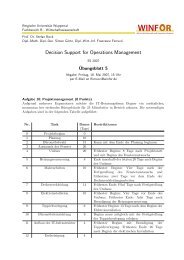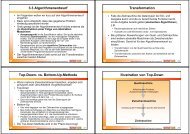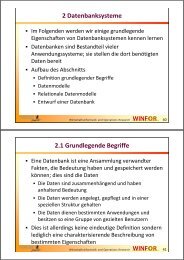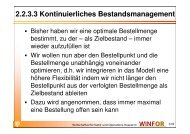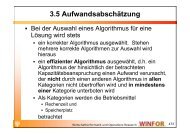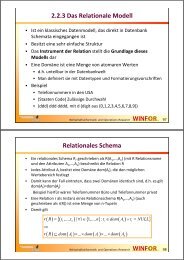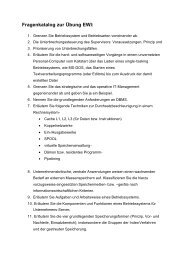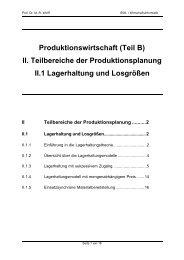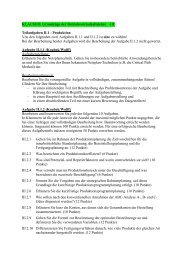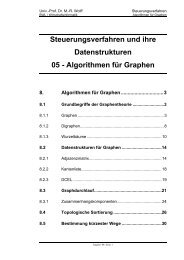(2/1) PDF - WINFOR
(2/1) PDF - WINFOR
(2/1) PDF - WINFOR
You also want an ePaper? Increase the reach of your titles
YUMPU automatically turns print PDFs into web optimized ePapers that Google loves.
8.3 Branch and Bound<br />
In what follows, we consider a second technique optimally solving<br />
general integer linear programs. Given an integer linear program<br />
denoted as M 0<br />
( ) ( )<br />
0 0<br />
M Min z x s. t. x ∈ P<br />
We consider a lower bound LM0 to M0 that is obtained from a<br />
relaxation and has a larger solution space LP0⊇P0 . We solve the<br />
relaxation to optimality and obtain its optimal solution x0 relaxation to optimality and obtain its optimal solution x<br />
LM = Min z( x) s. t. x ∈ LP<br />
0 0<br />
For example, LM 0 is the optimal objective function value of the LPrelaxation<br />
to M 0<br />
If x 0 ∈P 0 , then the problem M 0 is optimally solved.<br />
Otherwise: Branching (see next slide)<br />
Business Computing and Operations Research 647<br />
Branching<br />
We partition the solution space P 0 by some branching rule and yield<br />
k+1 subproblems M 00 …M 0k<br />
∪<br />
0 k 0i 0i 0 j<br />
, 0,..., : :<br />
i=<br />
1<br />
P = P ∧ ∀ i j = k i ≠ j P ∩ P = ∅<br />
( ) ( ) ( ) ( )<br />
00 01 0k 0k<br />
M Min z x s. t. x ∈ P ... M Min z x s. t. x ∈ P<br />
For example if P0 is the LP-relaxation, we choose a variable x 0 For example if P that is<br />
0 is the LP-relaxation, we choose a variable x 0<br />
j that is<br />
not integer and yield two subproblems with<br />
{ 0 j ⎡ j ⎤} { 0<br />
j ⎢ j ⎥}<br />
00 0 0 01 0 0<br />
P = x ≥ x ∈ P ∧ x ≥ ⎢x ⎥ P = x ≥ x ∈ P ∧ x ≤ ⎣x ⎦<br />
Business Computing and Operations Research 648
Enumeration tree obtained from Branching<br />
Applying the branching rule consecutively, we derive a<br />
solution tree<br />
M 0<br />
M 00 M 01<br />
M 000 M 001 M 002<br />
Some solutions of the subproblems may be integer.<br />
We stop if the solution tree is explored entirely and thus,<br />
the best known integer solution is optimal to M 0<br />
Business Computing and Operations Research 649<br />
Size of the enumeration tree<br />
Hmmm… Annoying is that its<br />
size grows exponentially!<br />
This can take ages to<br />
compute…<br />
But we can reduce<br />
the size by<br />
bounding…<br />
bounding… !<br />
Business Computing and Operations Research 650
Bounding<br />
There is always a global upper bound UM to the integer linear program<br />
M 0 . Either UM=∞ or UM is derived from a feasible solution to M 0<br />
We calculate a lower bound LM 0i , which is easy to calculate, for each<br />
subproblem M 0i and LM 0i has a solution space LP 0i ⊇P 0i ∀i=1,…,k.<br />
A subproblem M0i does not need to be considered any more (i.e., it is<br />
pruned) if one of the following pruning criterions hold:<br />
0i<br />
a) and the optimal solution x0i of LM0i is feasible to M0 a) LM < UM and the optimal solution x of LM is feasible to M : We<br />
found an improved upper bound to M0 and we remember this<br />
solution UM:= LM0i .<br />
b) : The optimal solution of the subproblem M0i LM < UM<br />
0i<br />
LM ≥ UM<br />
and all<br />
integer solutions derived from it cannot be better than the best<br />
known feasible solution with UM.<br />
0i<br />
c) : There exists no feasible solution to LM0i and none to M0i LP = ∅<br />
We stop if the solution tree is explored and thus, UM is optimal to M 0<br />
( 0 )<br />
M Minimize − x − 2 ⋅ x<br />
s.t. 2 ⋅ x + 2 ⋅ x ≤ 7<br />
1 2<br />
1 2<br />
−2 ⋅ x + 2 ⋅ x ≤ 1<br />
1 2<br />
−2 ⋅ x ≤ −1<br />
x ,x<br />
2<br />
≥ 0<br />
x ,x ∈Z<br />
1 2<br />
Business Computing and Operations Research 651<br />
1 2<br />
Example<br />
We commence with UM=∞ and with the LP-relaxation LM0 0<br />
7<br />
1<br />
−1<br />
−1 2<br />
−2<br />
0<br />
−2<br />
2<br />
2<br />
−2<br />
0<br />
1<br />
0<br />
0<br />
0<br />
0<br />
1<br />
0<br />
11<br />
0 2<br />
3<br />
0<br />
⇒ ... ⇒<br />
2<br />
0 3<br />
1<br />
2<br />
0<br />
1<br />
0<br />
0<br />
0<br />
0<br />
0<br />
1<br />
3<br />
4<br />
1<br />
4<br />
1<br />
2<br />
1<br />
4<br />
1<br />
4<br />
− 1<br />
4<br />
1<br />
2<br />
1<br />
4<br />
0<br />
0<br />
1<br />
0<br />
Business Computing and Operations Research 652
Consequences<br />
Obviously, -11/2 is a lower bound for the optimal solution<br />
value of M 0<br />
Since the solution is unfortunately not integer, we branch<br />
and conduct a case statement. Either x 1≤1 or x 1≥2<br />
Starting from the original set of feasible solutions<br />
{ ( 1 2 ) ≥0<br />
2 1 2 2 7 2 1 2 2 1 2 2 1 }<br />
0 2<br />
P = x ,x ∈ IR | 2 ⋅ x + 2 ⋅ x ≤ 7 ∧ − −2 ⋅ x + 2 ⋅ x ≤ 1 ∧ 2 ⋅ x ≤ − −1<br />
the simple branching step yields two subproblems<br />
{ ( 1 2 ) ≥0<br />
2 1 2 2 7 2 1 2 2 1 2 2 1 1 1}<br />
( ) 2 2 7 2 2 1 2 1 2<br />
00 2<br />
P x ,x IR | x x x x x x<br />
= ∈ ⋅ + ⋅ ≤ ∧ − ⋅ + ⋅ ≤ ∧ ⋅ ≤ − ∧ ≤ ∧<br />
{ 1 2 ≥0<br />
1 2 1 2 2 1 }<br />
= ∈ ⋅ + ⋅ ≤ ∧ − ⋅ + ⋅ ≤ ∧ ⋅ ≤ − ∧ ≥<br />
01 2<br />
P x ,x IR | x x x x x x<br />
Business Computing and Operations Research 653<br />
Resulting problems<br />
Consequently, we obtain the tableaus<br />
M M<br />
00 01<br />
11<br />
2<br />
0 0 3<br />
4<br />
1<br />
4<br />
0 0 11<br />
2<br />
0 0 3<br />
4<br />
1<br />
4<br />
0 0<br />
3<br />
2<br />
1 0 1<br />
4<br />
− 1<br />
4<br />
0 0 3<br />
2<br />
1 0 1<br />
4<br />
− 1<br />
4<br />
0 0<br />
3 0 0 1<br />
2<br />
1<br />
2<br />
1 0 3 0 0 1<br />
2<br />
1<br />
2<br />
1 0<br />
2 0 1 1<br />
4<br />
1<br />
2<br />
0 0 2 0 1 1<br />
4<br />
1<br />
2<br />
0 0<br />
1 1 0 0 0 0 1 2 1 0 0 0 0 −1<br />
Business Computing and Operations Research 654
Transformation of the tableaus<br />
In order to directly conduct the dual simplex, we<br />
need to transform the problem<br />
Specifically, we subtract the first row from the<br />
fourth one or vice versa<br />
Thus, we obtain<br />
11<br />
2<br />
0 0 3<br />
4<br />
1<br />
4<br />
0 0 11<br />
2<br />
0 0 3<br />
4<br />
1<br />
4<br />
0 0<br />
3<br />
2<br />
1 0 1<br />
4<br />
− 1<br />
4<br />
0 0 3<br />
2<br />
1 0 1<br />
4<br />
− 1<br />
4<br />
0 0<br />
3 0 0 1<br />
2<br />
1<br />
2<br />
1 0 3 0 0 1<br />
2<br />
1<br />
2<br />
1 0<br />
2 0 1 1<br />
4<br />
1<br />
2<br />
0 0 2 0 1 1<br />
4<br />
1<br />
2<br />
0 0<br />
− 1<br />
2<br />
0 0 − 1<br />
4<br />
1<br />
4<br />
0 1 − 1<br />
2<br />
0 0 1<br />
4<br />
− 1<br />
4<br />
0 1<br />
Business Computing and Operations Research 655<br />
Finally, it turns out…<br />
11<br />
2<br />
0 0 3<br />
4<br />
1<br />
4<br />
0 0 11<br />
2<br />
0 0 3<br />
4<br />
1<br />
4<br />
0 0<br />
3<br />
2<br />
1 0 1<br />
4<br />
− 1<br />
4<br />
0 0 3<br />
2<br />
1 0 1<br />
4<br />
− 1<br />
4<br />
0 0<br />
3 0 0 1<br />
2<br />
1<br />
2<br />
1 0 3 0 0 1<br />
2<br />
1<br />
2<br />
1 0<br />
2<br />
⎡− 1 ⎤<br />
⎣ 2⎦ 0<br />
0<br />
1<br />
0<br />
1<br />
4<br />
( − 1<br />
4) 1<br />
4<br />
1<br />
4<br />
0<br />
0<br />
0<br />
1<br />
2<br />
⎡− 1 ⎤<br />
⎣ 2⎦ 0<br />
0<br />
1<br />
0<br />
1<br />
4<br />
1<br />
4<br />
1<br />
4<br />
( − 1<br />
4)<br />
0<br />
0<br />
0<br />
1<br />
4 0 0 0 1 0 3 5 0 0 1 0 0 1<br />
1 1 0 0 0 0 1 2 1 0 0 0 0 −1<br />
2 0 0 0 1 1 2 2<br />
3<br />
2<br />
0 1 0 1<br />
2<br />
0 1<br />
2 0 0 1 −1 0 −4<br />
0 0 1 0 1 2<br />
3<br />
2<br />
0 1 1<br />
2<br />
0 0 1<br />
2 0 0 −1 1 0 −4<br />
Business Computing and Operations Research 656
Conclusions<br />
Unfortunately, both solutions are still not integer<br />
Thus, we have to resume with the next branching<br />
step<br />
This time, we obtain altogether four constellations<br />
000 { ( 1 2 ) 2<br />
≥ 0 2 1 2 2 7 2 1 2 2 1 2 2 1 1 1 2 1 }<br />
001 { ( 1 2 ) 2<br />
≥0<br />
2 1 2 2 7 2 1 2 2 1 2 2 1 1 1 2 2}<br />
010 { ( 1 2 ) 2<br />
≥0<br />
2 1 2 2 7 2 1 2 2 1 2 2 1 1 2 2 1}<br />
011<br />
= { ( 1 2 ) ∈<br />
2<br />
≥0<br />
2 ⋅ 1 + 2 ⋅ x2 ≤ 7 ∧ −2 ⋅ x1 + 2 ⋅ x2 ≤ 1∧ 2 ⋅ x2 ≤ −1∧ x1 ≥ 2 ∧ x2<br />
≥ 2}<br />
M = x ,x ∈ IR | ⋅ x + ⋅ x ≤ ∧ − ⋅ x + ⋅ x ≤ ∧ ⋅ x ≤ − ∧ x ≤ ∧ x ≤ ∧<br />
M = x ,x ∈ IR | ⋅ x + ⋅ x ≤ ∧ − ⋅ x + ⋅ x ≤ ∧ ⋅ x ≤ − ∧ x ≤ ∧ x ≥ ∧<br />
M = x ,x ∈ IR | ⋅ x + ⋅ x ≤ ∧ − ⋅ x + ⋅ x ≤ ∧ ⋅ x ≤ − ∧ x ≥ ∧ x ≤ ∧<br />
M x ,x IR | x<br />
M 001 and M 011 are infeasible (case c)<br />
Thus, we resume with M 000 and M 010<br />
Business Computing and Operations Research 657<br />
Resulting problems<br />
M M<br />
000 010<br />
4 0 0 0 1 0 3 0 5 0 0 1 0 0 1 0<br />
1 1 0 0 0 0 1 0 2 1 0 0 0 0 −1<br />
0<br />
2 0 0 0 1 1 2 0 2 0 0 1 0 1 2 0<br />
3<br />
2<br />
0 1 0 1<br />
2<br />
0 1 0 3<br />
2<br />
0 1 1<br />
2<br />
0 0 1 0<br />
2 0 0 1 −1 0 −4 0 2 0 0 −1 1 0 −4<br />
0<br />
1 0 1 0 0 0 0 1 1 0 1 0 0 0 0 1<br />
4 0 0 0 1 0<br />
3 0 5 0 0 1 0 0 1 0<br />
1 1 0 0 0 0 1 0 2 1 0 0 0 0 −1<br />
0<br />
2 0 0 0 1 1 2 0 2 0 0 1 0 1 2 0<br />
3<br />
2<br />
0 1 0 1<br />
2<br />
0 1 0 3<br />
2<br />
0 1 1<br />
2<br />
0 0 1 0<br />
2 0 0 1 −1 0 −4 0 2 0 0 −1 1 0 −4<br />
0<br />
( ) ( )<br />
− 1 0 0 0 − 1 0 −1 1 − 1 0 0 − 1 0 0 −1<br />
1<br />
2 2 2 2<br />
Business Computing and Operations Research 658
Resulting problems<br />
4 0 0 0 1 0 3 0 5 0 0 1 0 0 1 0<br />
1 1 0 0 0 0 1 0 2 1 0 0 0 0 −1<br />
0<br />
2 0 0 0 1 1 2 0 2 0 0 1 0 1 2 0<br />
3<br />
2<br />
0 1 0 1<br />
2<br />
0 1 0 3<br />
2<br />
0 1 1<br />
2<br />
0 0 1 0<br />
2 0 0 1 −1 0 −4 0 2 0 0 −1 1 0 −4<br />
0<br />
( ) ( )<br />
⎡− 1 ⎤ 0 0 0 − 1 0 −1 1 ⎡− 1 ⎤ 0 0 − 1 0 0 −1<br />
1<br />
⎣ 2 ⎦ 2 ⎣ 2 ⎦<br />
2<br />
3 0 0 0 0 0 1 2<br />
1 1 0 0 0 0 1 0<br />
1 0 0 0 0 1 0 2<br />
1 0 1 0 0 0 0 1<br />
3 0 0 1 0 0 −2 −2<br />
1 0 0 0 1 0 2 −2<br />
9<br />
2<br />
0 0 1<br />
2<br />
0 0 0 1<br />
5<br />
2<br />
1 0 1<br />
2<br />
0 0 0 −1<br />
1 0 0 0 0 1 0 2<br />
1 0 1 0 0 0 0 1<br />
4 0 0 1 1 0 0 −4<br />
1 0 0 1<br />
2 2<br />
0 0 1 −1<br />
Business Computing and Operations Research 659<br />
M 000 and M 010 – Results<br />
Obviously, the problems are optimally solved<br />
Thus, we obtain an integer solution with objective<br />
function value -3 from M 000 and we set UM:=-3<br />
(case a)<br />
Since the lower bound of the remaining problem<br />
M010 is -9/2, we have to resume with this problem<br />
Here, we obtain the new problems<br />
0100 2<br />
M { ( x 1,x 2 ) IR ≥0<br />
| 2 x1 2 x2 7 2 x1 2 x2 1 2 x2 1 x1 2 x2 1 x1<br />
2}<br />
0101 2<br />
M = { ( x 1,x 2 ) ∈ IR ≥0<br />
| 2 ⋅ x1 + 2 ⋅ x2 ≤ 7 ∧ −2 ⋅ x1 + 2 ⋅ x2 ≤ 1∧ 2 ⋅ x2 ≤ −1∧ x1 ≥ 2 ∧ x2 ≥ 2 ∧ x1<br />
≥<br />
3}<br />
= ∈ ⋅ + ⋅ ≤ ∧ − ⋅ + ⋅ ≤ ∧ ⋅ ≤ − ∧ ≥ ∧ ≤ ∧ ≤ ∧<br />
Business Computing and Operations Research 660
M 010 – Results<br />
M M<br />
0100 0101<br />
9<br />
2<br />
0 0 1<br />
2<br />
0 0 0 1 0 9<br />
2<br />
0 0 1<br />
2<br />
0 0 0 1 0<br />
5<br />
2<br />
1 0 1<br />
2<br />
0 0 0 −1 0 5<br />
2<br />
1 0 1<br />
2<br />
0 0 0 −1<br />
0<br />
1 0 0 0 0 1 0 2 0 1 0 0 0 0 1 0 2 0<br />
1 0 1 0 0 0 0 1 0 1 0 1 0 0 0 0 1 0<br />
4 0 0 1 1 0 0 −4<br />
0 4 0<br />
0 1 1 0 0 −4<br />
0<br />
1<br />
2<br />
0 0 1<br />
2<br />
0 0 1 −1<br />
0 1<br />
2<br />
0 0 1<br />
2<br />
0 0 1 −1<br />
0<br />
2 1 0 0 0 0 0 0 1 3 1 0 0 0 0 0 0 − 1<br />
9<br />
2<br />
0 0 1<br />
2<br />
0 0 0 1 0 9<br />
2<br />
0 0 1<br />
2<br />
0 0 0 1 0<br />
5<br />
2<br />
1 0 1<br />
2<br />
0 0 0 −1 0 5<br />
2<br />
1 0 1<br />
2<br />
0 0 0 −1<br />
0<br />
1 0 0 0 0 1 0 2 0 1 0 0 0 0 1 0 2 0<br />
1 0 1 0 0 0 0 1 0 1 0 1 0 0 0 0 1 0<br />
4 0 0 1 1 0 0 −4 0 4 0 0 1 1 0 0 −4<br />
0<br />
1<br />
2<br />
0 0 1<br />
2<br />
0 0 1 −1 0 1<br />
2<br />
0 0 1<br />
2<br />
0 0 1 −1<br />
0<br />
− 1<br />
2<br />
0 0 − 1<br />
2<br />
0 0 0 1 1 − 1<br />
2<br />
0 0 1<br />
2<br />
0 0 0 −1<br />
1<br />
Business Computing and Operations Research 661<br />
And thus, we obtain<br />
9<br />
2<br />
0 0 1<br />
2<br />
0 0 0 1 0 9<br />
2<br />
0 0 1<br />
2<br />
0 0 0 1 0<br />
5<br />
2<br />
1 0 1<br />
2<br />
0 0 0 −1 0 5<br />
2<br />
1 0 1<br />
2<br />
0 0 0 −1<br />
0<br />
1 0 0 0 0 1 0 2 0 1 0 0 0 0 1 0 2 0<br />
1 0 1 0 0 0 0 1 0 1 0 1 0 0 0 0 1 0<br />
4 0 0 1 1 0 0 −4 0 4 0 0 1 1 0 0 −4<br />
0<br />
1 1 1 1<br />
2<br />
0 0<br />
2<br />
0 0 1 −1 0<br />
2<br />
0 0<br />
2<br />
0 0 1 −1<br />
0<br />
⎡− 1 ⎤ 0 0 ( − 1 ) 0 0 0 1 1 ⎡− 1 ⎤ 0 0 1 0 0 0 ( −1)<br />
1<br />
⎣ 2 ⎦ ( 2 2) ⎣ 2 ⎦ 2<br />
( )<br />
4<br />
2<br />
1<br />
1<br />
0<br />
1<br />
0<br />
0<br />
0<br />
0<br />
0<br />
1<br />
0<br />
0<br />
0<br />
0<br />
0<br />
0<br />
0<br />
0<br />
0<br />
0<br />
1<br />
0<br />
0<br />
0<br />
0<br />
0<br />
2<br />
0<br />
2<br />
1<br />
4<br />
1<br />
3<br />
1<br />
0<br />
0<br />
1<br />
0 2<br />
0<br />
1<br />
0<br />
0<br />
0<br />
0<br />
0<br />
1<br />
1<br />
0<br />
1<br />
1<br />
2<br />
0<br />
0<br />
0<br />
0<br />
0<br />
0<br />
1<br />
0<br />
0<br />
0<br />
0<br />
0<br />
0<br />
0<br />
0<br />
0<br />
1<br />
−1<br />
2<br />
1<br />
3 0 0 0 1 0 0 −4 −2 6 0 0 −1 1 0 0 0 −4<br />
0 0 0 0 0 0 1 0 1 1 0 0 0 0 0 1 0 −1<br />
1 0 0 1 0 0 0 2 2 1 0 0 1<br />
2<br />
−<br />
2<br />
0 0 0 1 −1<br />
Business Computing and Operations Research 662
M 0100 and M 0101 – Results<br />
We obtained an improved second feasible<br />
solution x T =(2,1) from M 0100 and UM:=-4 (case a)<br />
The other alternative constellation M 0101 still does<br />
not provide any integer solution<br />
However, since the objective function value is -4,<br />
this is a lower bound for all integer solutions<br />
resulting from M0101 (case b)<br />
Thus, we explored the solution tree and stop our<br />
procedure. The optimal solution is x T =(2,1) with<br />
an objective function value of UM=-4<br />
Business Computing and Operations Research 663<br />
Example – Conducted exploration process<br />
00 00<br />
( )<br />
LM = − 4 x = 1,3/ 2<br />
x1 ≤ 1<br />
M 0<br />
0 0<br />
M 00 M 01<br />
( )<br />
LM = − 11/ 2 x = 3/ 2,2 UM = ∞<br />
x1 ≥ 2<br />
01 01<br />
( )<br />
LM = − 5 x = 2,3/ 2<br />
x2 ≤ 1<br />
x2 ≥ 2 x2 ≤ 1<br />
x2 ≥ 2<br />
M000 M001 M010 M011 M M M 010<br />
x = ( 5/ 2,1 )<br />
M<br />
x = 5/ 2,1<br />
LM<br />
x<br />
000<br />
000<br />
=<br />
case a)<br />
000<br />
= −3<br />
( 1,1)<br />
case c)<br />
001<br />
LM < UM ⇒ UM : = −3<br />
P = ∅<br />
LM<br />
010<br />
= −9/<br />
2<br />
x1 ≤ 2<br />
x1 ≥ 3<br />
M 0100 M 0101<br />
LM<br />
x<br />
0100<br />
0100<br />
=<br />
case a)<br />
0100<br />
= −4<br />
( 2,1)<br />
LM < UM ⇒ UM : = −4<br />
Optimal Solution<br />
LM<br />
0101<br />
0101<br />
case b)<br />
0101<br />
= −4<br />
( 3,1/ 2)<br />
case c)<br />
Business Computing and Operations Research 664<br />
x<br />
=<br />
LM ≥<br />
UM<br />
011<br />
P = ∅
Branch and Bound Algorithm<br />
1. Determine an upper bound UM either via a heuristic or set UM:=∞<br />
2. Solve a lower bound LM i of M i and obtain its optimal solution x i<br />
3. If either LM i ≥UM (case b) or P i =Ø (case c) hold, then go to 7.<br />
4. Otherwise (Case b) or c) do not apply): If LM i


